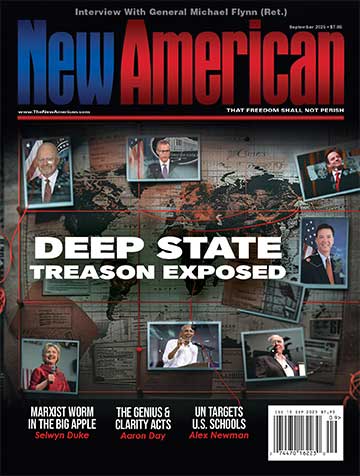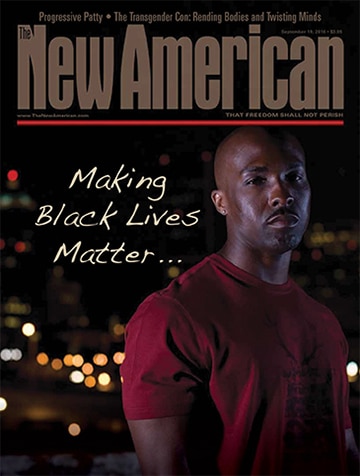A War of Lies
In an era of violent riots, looting, and the murder of police officers in cities as diverse as Dallas and Baton Rouge — largely instigated by the rhetoric and actions of Black Lives Matter (BLM) — Heather Mac Donald’s newest book could not be more timely. The War on Cops: How the New Attack on Law and Order Makes Everyone Less Safe, published in June by Encounter Books, offers a clear analysis of the danger behind the newest wave of the war on police and the cost America’s cities are paying in lives and property as law and order are sacrificed at the altar of political correctness.
Heather Mac Donald is a John M. Olin Fellow at the Manhattan Institute for Policy Research and a prolific writer on a variety of conservative — and controversial — topics. She has written for the Wall Street Journal, is a contributing editor to the Manhattan Institute’s City Journal, and has been called as an expert witness on criminal justice policy, besides authoring several books.
Through compelling real-life accounts and incontrovertible data, The War on Cops dismantles and exposes the lies of BLM and the liberal politicians behind the policies that have grown out of those lies. With facts and statistical data, Mac Donald squares off against the liberal narrative of BLM on topics ranging from Ferguson to Baltimore, from BLM’s claims that police unfairly target blacks to the rising crime rates as proactive policing is reduced, from the disproportionately high black-on-black murder rate to the fact that police are, as Mac Donald puts it, “the government agency most committed to the proposition that ‘black lives matter.’” And — with the honest facts on her side — she tells it like it is, without either apology or the need for apology.
The war on police has a decided racial (even racist) foundation. The narrative of BLM and its apologists — in both government and media — is that cops (mostly white cops) systematically make black men the targets of stops, citations, arrests, violence, and even murder. In a world that is increasingly divided by race, it is almost impossible to have a reasonable discussion about this issue. If the writer or speaker is black and points out the fact that the vast majority of violent crime is committed by black men, he or she will be branded a “sellout.” If the writer or speaker is white, the brand reads “racist.” The same branding holds true if a writer or speaker of any race points out that a high number of black stops, citations, and arrests happen because cops go where the crime is and that means inner-city neighborhoods, which are often mostly black. The branding escalates if one dares to point out that — in most cases — the black men who die at the hands of police were in the act of committing a violent crime and that they are ultimately responsible for their own deaths.
Mac Donald came armed with enough well-researched facts to deflect much of that and a reasoned tone tempered with compassion for the black victims of black crime, knowing that her detractors would dismiss anything other than a regurgitation of the oft-repeated claims of BLM.
Mac Donald tackles those claims head on. After illustrating that crime — especially violent crime — has been declining since the 1990s as a direct result of proactive policing policies such as the controversial “Broken Windows” model (which has become one of BLM’s favorite whipping boys), she writes that as those effective policies are being abandoned, the gains in law and order are beginning to reverse:
Now, that triumph over chaos and lawlessness is in jeopardy. Fueling the rise in crime in places like Baltimore and Milwaukee is a multipronged attack on law enforcement. Since late summer 2014, a protest movement known as Black Lives Matter has convulsed the nation. Triggered by a series of highly publicized deaths of black males at the hands of the police, the Black Lives Matter movement holds that police officers are the greatest threat facing young black men today. That belief has spawned riots, “die-ins,” and the assassination of police officers. The movement’s targets include Broken Windows policing and the practice of stopping and questioning suspicious individuals, both of which are said to harass blacks.
“Broken Windows” is a policing policy that, Mac Donald explains, “holds that allowing a neighborhood to become overrun by graffiti, litter, public drunkenness, and other forms of disorder breeds more crime by signaling that social control in the area has collapsed.” By enforcing laws against vandalism, public drunkenness, urinating in the streets, etc., police send the opposite message: Law and order will prevail. The effect of this policy — in conjunction with other similar policies — led to the decline in crime, Mac Donald says. And she also asserts that its abandonment has led to an increase in crime. She offers ample evidence in the way of crime data and the personal testimony of those most impacted by the shift away from such proactive policing: poor, black residents of inner-city neighborhoods.
As cities across America have responded to the war on police by blaming police and the effective policing policies on which they rely to keep those cities safe, there has been a phenomenon of de-policing, known as the Ferguson Effect — a phrase Mac Donald helped coin that refers to the unrest after the 2014 shooting of Michael Brown, an 18-year-old black man, by a white police officer in Ferguson, Missouri. As individual officers and whole departments move away from proactive policing, all that is left is reactive policing. Instead of providing a police presence and preventing higher-level crime by arresting the criminal for lower-level crime before he escalates, cops are showing up at more and more scenes of robbery, rape, and murder to fill out reports and find the criminal who is — more often than not — described by victims and witnesses as a black male. The war on police then demonizes those cops for focusing on black men in the investigation. Talk about a rock and hard place.
As Mac Donald describes the Ferguson Effect:
As 2015 progressed, few law-enforcement practices escaped attack for allegedly imposing unjust burdens on blacks. But it was the virulent anti-cop rhetoric that was most consequential. Officers working in inner cities routinely found themselves surrounded by hostile, jeering crowds when they tried to make an arrest or conduct an investigation. Cops feared becoming the latest YouTube pariah when a viral cell-phone video showed them using force against a suspect who had been resisting arrest.
Mac Donald shows statistically what many others — including George Mason University economist Walter Williams and Stanford University economist Thomas Sowell (both of whom are black men who have been branded as “Uncle Toms”) — have shown previously: The decline in black culture — which is responsible for the high rate of crime in black communities — is the result of the disintegration of the black two-parent family.
There is a law at work in the universe that states that those who will not govern themselves internally will be governed by others externally. In the absence of self-government, there is a self-imposed necessity for greater police presence and action. As crime rises in those neighborhoods, the law-abiding who live in terror of that crime need more police presence and more police involvement, not less. Mac Donald wrote:
Until the black family is reconstituted, the best protection that the law-abiding residents of urban neighborhoods have is the police.
Unfortunately, as Mac Donald illustrates, BLM and its supporters do not share her concern for the well-being of the residents of those poor, black neighborhoods besieged by crime. As cops “began to disengage from proactive policing,” driving past suspicious characters in neighborhoods known to be pockets of high crime, ignoring the obvious gun-shaped bulge under the over-sized sports jersey, those same cops simply returned later to file reports of the robberies, rapes, and murders and then set off searching for a suspect they could have stopped had they not been hamstrung by the Ferguson Effect of BLM. As Mac Donald wrote:
If the Black Lives Matter movement were correct, this falloff in discretionary policing should have been a boon to black lives. Instead, a bloodbath ensued, and its victims were virtually all black. When the cops back off, blacks pay the greatest price. That truth would have come as no surprise to the legions of inner-city residents who fervently support the police and whose voices are almost never heard in the media.
Sadly, those “black lives” join the police as casualties in the war on cops, which Mac Donald’s book reveals in all its ugliness.
Many readers may worry that Mac Donald advocates for a heavy-handed policing of America’s cities — especially given her defense of overreaching federal powers in her previous books. If there are elements of that mind-set in The War on Cops, they are subtle and do not detract from her convincing arguments that proactive policing works, and stopping proactive programs helps one group: criminals.
The War on Cops: How the New Attack on Law and Order Makes Everyone Less Safe, by Heather Mac Donald, New York, New York: Encounter Books, 2016, 248 pages, hardcover.



